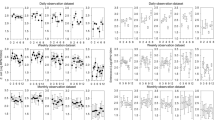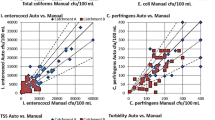Abstract
Pathogens in surface waters continue to be a worldwide concern. The potential presence of pathogens is often identified through the use of fecal indicator bacteria such as fecal coliform, E. coli, and enterococci, each of which are still utilized worldwide depending on local regulations. Urban stormwater runoff has been shown to convey fecal indicator bacteria to surface waters; however, the fate and transport dynamics of these microbes in urban stormwater are not well established. This is particularly the case for intra-event (within event) processes. The intra-event characteristics of total suspended solids and three types of fecal indicator bacteria (FIB), fecal coliform, E. coli, and enterococci, were analysed for a watershed in Raleigh, NC, USA. FIB showed higher variability than TSS among intra-event characteristics such as normalized peak concentration, rate of change, and normalized concentration in the first 3 mm of rainfall (C3mm), but similar variability in concentrations throughout each storm. FIB intra-event statistics appear to be influenced by climate variables whereas total suspended sediments statistics are most influenced by hydrologic variables. Changes in intra-event total suspended concentrations were consistently well described by rainfall intensity, while FIB correlations with rainfall intensity were weaker and inconsistent between events. This study showed similar patterns of variability among the intra-event FIB statistics and comparable correlations to climatic and hydrologic variables between fecal coliform, E. coli, and enterococci. Thus, similar processes appear to influence the variability of all three indicator bacteria, suggesting that microbial models may be adaptable amongst various types of FIB.





Similar content being viewed by others
References
Aladenola OO, Adeboye OB (2010) Assessing the potential for rainwater harvesting. Water Resour Manag 24(10):2129–2137
Al-Salaymeh A, Al-Khatib IA, Arafat HA (2011) Towards sustainable water quality: management of rainwater harvesting cisterns in southern Palestine. Water Resour Manag 25(6):1721–1736
American Public Health Association, American Water Works Association, and Water Environment Federation (APHA, AWWA, and WEF) (1998) Standard methods for the examination of water and wastewater, 20th edn. American Public Health Association, Alexandria
Anderson KL, Whitlock JE, Harwood VJ (2005) Persistence and differential survival of fecal indicator bacteria in subtropical water and sediments. Appl Environ Microbiol 71(6):3041–3048
Bach PM, McCarthy DT, Deletic A (2010) Redefining the stormwater first flush phenomenon. Water Res 44(8):2487–2498
Burton GA, Pitt RE (2002) Stormwater effects handbook: a toolbox for watershed managers, scientists, and engineers. CRC Press, LLC., Boca Raton
Chiew FHS, Peel MC, Western AW (2002) Application and testing of the simple rainfall-runoff model SimHyd. In: Singh VP, Frevert DK (eds) Mathematical models of small watershed hydrology and applications. Water Resources Publication, Colorado
Chow MF, Yusop Z, Toriman ME (2013) Level and transport pattern of faecal coliform bacteria from tropical urban catchments. Water Sci Technol 67(8):1822–1831
Crane SR, Moore JA (1986) Modeling enteric bacterial dieoff: a review. Water Air Soil Pollut 27:411–439
Duncan HP (1995) A review of urban stormwater quality processes. CRC for Catchment Hydrology, Victoria
Eleria A, Vogel RM (2005) Predicting fecal coliform bacteria levels in the Charles River, Massachusetts, USA. J Am Water Resour Assoc 41(5):1195–1209
Ferguson CM, Coote BG, Ashbolt NJ, Stevenson IM (1996) Relationships between indicators, pathogens, and water quality in an estuarine system. Water Res 30(9):2045–2054
Ferguson C, de Roda Husman AM, Altavilla N, Deere D, Ashbolt N (2003) Fate and transport of surface water pathogens in watersheds. Crit Rev Environ Sci Technol 33(3):299–361
Fries JS, Characklis GW, Noble RT (2006) Attachment of fecal indicator bacteria to particles in the Neuse River Estuary, N.C. J Environ Eng 132(10):1338–1345
Hathaway JM, Hunt WF (2011) Evaluation of first flush for indicator bacteria and total suspended solids in urban stormwater runoff. Water Air Soil Pollut 217:135–147
Hathaway JM, Hunt WF, Simmons OD III (2010) Statistical evaluation of factors affecting indicator bacteria in urban storm-water runoff. J Environ Eng 136(12):1360–1368
Hathaway JM, Hunt WF, Graves AK, Bass KL, Caldwell A (2011) Exploring fecal indicator bacteria in a constructed stormwater wetland. Water Sci Technol 63(11):2707–2712
Hathaway JM, Tucker RS, Spooner JM, Hunt WF (2012) A traditional analysis of the first flush effect for nutrients in stormwater runoff from two small urban catchments. Water Air Soil Pollut 223(9):5903–5915
He J, Valeo C, Chu A, Neumann NF (2010) Characteristics of suspended solids, microorganisms, and chemical water quality in event-based stormwater runoff from an urban residential area. Water Environ Res 82(12):2333–2345
Jan C, Chang C, Lee M (2006) Discussion of ‘Design and calibration of a compound sharp-crested weir’ by J. Martinez, J. Reca, M.T. Morillas, and J.G. Lopez. J Hydraul Eng 132(8):868–871
Jewell TK, Adrian DD (1981) Development of improved stormwater quality models. J Environ Eng Div 107:957–974
Line DE, White NM, Kirby-Smith WW, Potts JD (2008) Fecal coliform export from four coastal North Carolina areas. J Am Water Resour Assoc 44(3):606–617
Liu A, Li D, Guan Y (2014) Understanding the role of urban road surface characteristics in influencing stormwater quality. Water Resour Manag 28:5217–5229
McCarthy DT (2009) A traditional first flush assessment of E. coli in urban stormwater runoff. Water Sci Technol 60(11):2749–2757
McCarthy DT, Mitchell VG, Deletic A, Diaper C (2007) Escherichia coli in urban stormwater: explaining their variability. Water Sci Technol 56(11):27–34
McCarthy DT, Deletic A, Mitchell VG, Diaper C (2011) Development and testing of a model for Micro-Organism Prediction in Urban Stormwater (MOPUS). J Hydrol 409(1–2):236–247
McCarthy DT, Hathaway JM, Hunt WF, Deletic A (2012) Intra-event variability of Escherichia coli and total suspended solids in urban stormwater runoff. Water Res 46(20):6661–6670
Mitchell VG, Deletic A, Fletcher TD, Hatt BE, McCarthy DT (2007) Achieving multiple benefits from stormwater harvesting. Water Sci Technol 55(4):135–144
Nnaji CC, Mama NC (2014) Preliminary assessment of rainwater harvesting potential in Nigeria: focus on flood mitigation and domestic water supply. Water Resour Manag 28:1907–1920
Novotny V, Olem H (1994) Water quality prevention, identification and management of diffuse pollution. Van Nostrand Reinhold, New York, 1054p
Schoonover JE, Lockaby BG (2006) Land cover impacts on stream nutrients and fecal coliform in the lower piedmont of West Georgia. J Hydrol 331:371–382
Selvakumar A, Borst M (2006) Variation of microorganism concentrations in urban stormwater runoff with land use and seasons. J Water Health 4(1):109–124
Shen HW, Julien P (1993) Chapter 12: erosion and sediment transport. In: Maidment DR (ed) Handbook of hydrology. McGraw-Hill, Inc, US
Sinton LW, Hall CH, Lynch PA, Davies-Colley RJ (2002) Sunlight inactivation of fecal indicator bacteria and bacteriophages from waste stabilization pond effluent in fresh and saline waters. Appl Environ Microbiol 68(3):1122–1131
St Laurent J, Mazumder A (2014) Influence of seasonal and inter-annual hydro-meteorological variability on surface water fecal coliform concentration under varying land-use composition. Water Res 48:170–178
Struck SD, Selvakumar A, Borst M (2008) Prediction of effluent quality from retention ponds and constructed wetlands for managing bacterial stressors in storm-water runoff. J Irrig Drain Eng 134(5):567–578
Tsihrintzis VA, Hamid R (1997) Modeling and management of urban stormwater runoff quality: a review. Water Resour Manag 11:137–164
United States Environmental Protection Agency (USEPA) (1986) Ambient water quality criteria for bacteria – 1986. EPA 440/5-84-002. Office of Water, Washington, DC
United States Environmental Protection Agency (USEPA) (2003) Bacterial water quality standards for recreational waters: status report. EPA-823-R-03-008. Office of Water, Washington, DC
Vaze J, Chiew FHS (2003) Comparative evaluation of urban storm water quality models. Water Resour Res 39:10
World Health Organization (WHO) (2003) Guidelines for safe recreational water environments, volume 1: coastal and fresh waters. ISBN 92 4 154580 1. Geneva, Switzerland
Yacub GP, Castric DA, Stadterman-Knauer KL, Tobin MJ, Blazina M, Heineman TN, Yee GY, Frazier L (2002) Evaluation of Colilert and Enterolert defined substrate methodology for wastewater applications. Water Environ Res 74(2):131–135
Young KD, Thackston EL (1999) Housing density and bacterial loading in urban streams. J Environ Eng 125:1177–1180
Acknowledgments
The writers would like to recognize the North Carolina Department of Environment and Natural Resources for funding this project, and thank Shawn Kennedy for his work installing monitoring equipment.
Author information
Authors and Affiliations
Corresponding author
Rights and permissions
About this article
Cite this article
Hathaway, J.M., Hunt, W.F. & McCarthy, D.T. Variability of Intra-event Statistics for Multiple Fecal Indicator Bacteria in Urban Stormwater. Water Resour Manage 29, 3635–3649 (2015). https://doi.org/10.1007/s11269-015-1020-0
Received:
Accepted:
Published:
Issue Date:
DOI: https://doi.org/10.1007/s11269-015-1020-0




